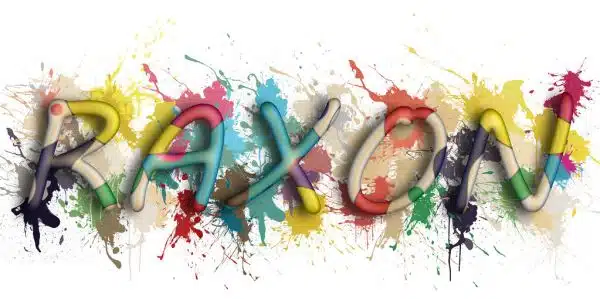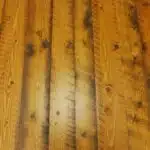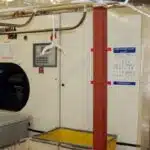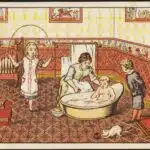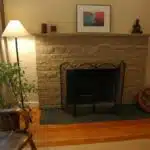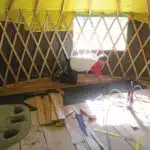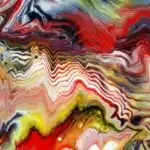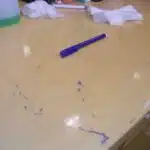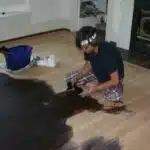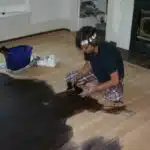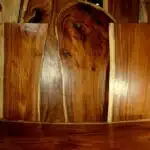As a professional cleaner or housekeeper, you know that paint spills and drips are common occurrences when working on home improvement projects. While painting can transform the look of a room, it can also leave behind stubborn stains on your beautiful hardwood floors. Removing paint from wood floors requires careful attention to prevent further damage to the surface. In this article, we will discuss the best ways to clean paint spills and drips off wood floors.
Firstly, it is important to identify what type of paint has spilled on your floor. Different types of paints have different chemical properties and require different cleaning methods. For instance, latex or water-based paints are easier to remove than oil-based paints which require stronger solvents for effective cleaning. Additionally, it is crucial to clean up any paint spill immediately before it sets in and dries up. Failure to do so may result in permanent damage to your hardwood floor’s finish, requiring costly repairs or replacement. By following the tips provided in this article, you can effectively clean up any paint spills or drips on your wood floors and restore their natural beauty.
Identifying The Type Of Paint Spill
Paint spills and drips are common occurrences when working with paint. These can be frustrating to deal with, especially if they get onto your hardwood floors. The first step in cleaning a paint spill or drip off of wood is identifying the type of paint that was spilled.
Identifying techniques for paint spills include looking at the label or container to determine if it is oil-based or water-based paint. This information will help you choose the right cleaning solution and technique for removing the spill. If the label is not available, you can try testing a small area with rubbing alcohol or vinegar to see how it reacts. A water-based paint will usually come off easily with warm water and soap, while an oil-based paint may require solvents such as mineral spirits or turpentine.
One common mistake people make when trying to clean up a paint spill is using too much water, which can cause damage to hardwood floors by warping or staining them. It’s important to use only a small amount of liquid at a time when cleaning up a spill, and to avoid scrubbing too hard as this can also cause damage. With proper identification techniques and careful cleaning procedures, however, most spills can be removed without damaging your hardwood floors.
To prepare the cleaning solution necessary for this task…
Preparing The Cleaning Solution
Gather the necessary supplies such as a mop, bucket, and cleaning solution. Begin by mixing the necessary ingredients to create a cleaning solution. Before use, test the solution on a small, inconspicuous area of the wood floor to ensure there will be no damage. Take note of the results, and adjust the solution as needed. Once satisfied with the results, proceed with using the solution on the wood floor. Ensure to thoroughly mix the solution before each use. After completing the cleaning, dispose of the solution properly.
Gather Supplies
To effectively clean paint spills and drips off wood floors, it is important to gather all the necessary supplies beforehand. Organizing supplies can help streamline the cleaning process and ensure that everything needed is readily available. Some essential items include a bucket, warm water, a sturdy scrub brush with stiff bristles, old rags or towels, and protective gloves.
Choosing cleaning agents is also an important step in preparing the cleaning solution for wood floors. It is important to avoid using harsh chemicals or abrasive materials that can damage the finish of the wood. Instead, opt for gentle solutions such as dish soap or vinegar diluted in water. These solutions are effective at breaking down and removing paint stains without causing any harm to the wood.
In addition to these basic supplies, there may be additional tools or materials that are specific to certain types of paint spills or drips. For example, if dealing with oil-based paint spills, mineral spirits may be needed for effective removal. By taking the time to gather all necessary supplies before beginning the cleaning process, you can ensure that your efforts will be successful in removing paint stains from your wood floors.
Mix Ingredients
To effectively clean paint spills and drips off wood floors, preparing the cleaning solution is an essential step. One important aspect is mixing the ingredients to create a solution that can effectively break down and remove the paint stains without harming the wood’s finish. There are different mixing techniques, depending on the cleaning agents used.
For instance, if using dish soap or vinegar diluted in water, mix thoroughly until all components are well-dissolved. Alternatively, for oil-based paint spills, use mineral spirits as a cleaning agent. However, it is crucial to use these solutions sparingly and avoid letting them sit on the wood surface for too long. This could cause damage or discoloration to the floor.
Moreover, there are alternative solutions that can be mixed to prepare a cleaning solution for wood floors. For example, rubbing alcohol mixed with warm water can be an effective way to remove fresh paint stains quickly. Another option is using baking soda mixed with water to create a paste-like consistency that can help loosen up old and stubborn paint stains before scrubbing them away.
By taking time to mix ingredients correctly and finding alternative solutions when necessary, one can ensure that any paint spills or drips on wood floors will be cleaned effectively without causing any harm to the surface.
Test Solution
In preparing the cleaning solution for wood floors, it is important to test the solution first before using it on the entire surface. This step is crucial to avoid damage or discoloration to the wood floor. Alternative methods can be used to test the solution, such as applying a small amount of the cleaning agent on an inconspicuous area of the floor.
Safety precautions should also be considered when testing and using cleaning solutions. It is essential to wear protective gloves and goggles when handling strong chemicals such as mineral spirits. Additionally, proper ventilation should be ensured during the cleaning process.
In conclusion, testing the cleaning solution and following safety precautions are important steps in effectively removing paint spills and drips off wood floors without causing damage or discoloration to the surface. By incorporating alternative methods and taking necessary precautions, one can ensure that their wood floors will look clean and beautiful for years to come.
Testing The Cleaning Solution On A Small Area
Before applying the cleaning solution on your wood floors, it is necessary to test a small area first. Testing the solution can help determine its effectiveness and avoid any damage that might be caused by using the wrong cleaning agent or method. It is important to note that different types of wood flooring may have varying reactions to different cleaning solutions, so testing is crucial.
When testing, select an inconspicuous area of the floor and apply a small amount of the solution with a clean cloth or sponge. Leave it for a few minutes before wiping it off with a damp cloth. Observe if there are any changes in the wood’s color, texture, or finish. If there are no negative reactions, then you may proceed with applying the solution to the rest of the affected areas.
The importance of patience cannot be emphasized enough when cleaning paint spills and drips off wood floors. Rushing through the process can cause more harm than good as it increases the chances of spreading paint residue or damaging delicate wooden surfaces. Proper ventilation during cleaning is also essential as some cleaning agents contain strong chemicals that emit fumes harmful to one’s health.
- A clean floor promotes better indoor air quality which contributes to overall health and wellness.
- Taking time to properly clean spills and drips can prevent further damage and extend your wood flooring’s lifespan.
- Cleaning regularly not only maintains your wood floors’ beauty but also prevents dirt buildup that causes scratches and dullness.
- A well-maintained home exudes comfort and relaxation for everyone in it.
- Properly cleaned floors make a room look more spacious and inviting.
Before gathering all necessary cleaning tools, testing your chosen solution on an inconspicuous area should be done first. Once you’ve determined its effectiveness, you may proceed with gathering all necessary equipment such as gloves, goggles, a bucket of warm water, clean cloths or sponges, and your chosen cleaning agent.
Gathering The Necessary Cleaning Tools
To effectively clean paint spills and drips off wood floors, you must gather the necessary cleaning tools. Before starting, it is important to protect the surrounding area to prevent further damage. To do this, cover any furniture or fixtures near the affected area with a plastic sheet or tarp. This will ensure that no additional paint gets on them during the cleaning process.
The right cleaning solution can make all the difference when cleaning paint spills off wood floors. There are several options to choose from depending on the type of paint spill and finish of your wood floor. If the spill is still wet, use a damp cloth to wipe it away before it dries. For dried or stubborn stains, try using rubbing alcohol, paint thinner or mineral spirits. Be sure to test any cleaning solution in an inconspicuous spot before applying it to a larger area.
In addition to choosing appropriate cleaning solutions, having the right tools is essential for removing paint spills and drips from wood floors effectively. A putty knife can be used to scrape away any excess dried paint without damaging the wood surface. A soft-bristled brush or old toothbrush can also be helpful for getting into crevices and corners. Once you have gathered all necessary tools and supplies, you can begin working on removing wet paint spills from your wood floors.
| Cleaning Solutions | Type of Paint Spill | Appropriate Surfaces |
|---|---|---|
| Rubbing Alcohol | Water-Based Paints | High Gloss Finishes |
| Mineral Spirits | Oil-Based Paints | Satin Finishes |
| Paint Thinner | Latex Paints | Matte Finishes |
With these tips in mind, gathering necessary cleaning tools should be simple and stress-free. Remember that protecting surrounding areas is crucial before beginning any cleanup effort. In the next section, we will discuss how to remove wet paint spills from wood floors effectively without causing further damage to your flooring surface.
Removing Wet Paint Spills
As we have discussed in the previous section, gathering the necessary cleaning tools is crucial when it comes to cleaning paint spills and drips off wood floors. In addition to cleaning supplies, protective gear should also be considered before beginning any cleaning process. Protective gear such as gloves, goggles, and a face mask can provide protection from harmful chemicals found in some cleaning products.
Now that you have your cleaning supplies and protective gear ready, let’s move on to removing wet paint spills. First, you will need to act fast and clean up the spill as soon as possible. If left for too long, wet paint spills can dry and become more difficult to remove later on. Use a clean cloth or paper towel to blot up as much of the spill as possible. Avoid rubbing the spill as this will only spread it further.
When dealing with wet paint spills on wood floors, remember not to use hot water or any harsh chemicals that may damage the finish of your floors. Instead, use a mild soap solution mixed with warm water to gently scrub the affected area. Rinse thoroughly with clean water and pat dry with a clean cloth or paper towel. With these steps completed, you should now have successfully removed any wet paint spills from your wood floors.
Moving forward into scraping dried paint spills off wood floors requires a different approach than dealing with wet spills.
Scraping Dried Paint Spills
- To effectively remove dried paint spills from wood floors, the most important tool is a putty knife or scraper.
- When scraping paint from the floor, it is important to use a light but firm pressure to ensure that the paint is removed without damaging the floor.
- A stiff-bristled brush can also be used to help remove any remaining paint and debris before vacuuming.
- When scraping paint from the floor, it is best to work in small sections and use a back-and-forth motion to ensure that all of the paint is properly removed.
Scraping Tools
When it comes to removing dried paint spills from wood floors, scraping tools are essential. The best brands of scraping tools for this purpose are those made of durable and sharp metals, such as steel or tungsten carbide. These materials effectively remove the hardened paint without damaging the wood surface.
For those who prefer alternative options, plastic scrapers are also available. While not as strong as metal scrapers, they are still effective in removing dried paint spills without scratching or gouging the wood floor. Additionally, plastic scrapers tend to be more affordable than their metal counterparts.
When using scraping tools, it’s important to apply gentle pressure and avoid using excessive force that can damage the wood floor. Take time to carefully scrape off the paint until it is completely removed from the surface. With the right scraping tool and technique, any dried paint spill on a wood floor can easily be removed without leaving behind unsightly marks or scratches.
Scraping Techniques
Paint removal from wood floors can be a challenging task, especially when dealing with dried paint spills. Scraping tools are essential in removing hardened paint without damaging the wood surface. However, it’s not just about having the right tool; proper scraping techniques must also be used to ensure effective and safe removal of the paint.
One of the most important things to remember when using scraping tools for paint removal is to apply gentle pressure. Excessive force can cause scratches or gouges on the wood floor, which can affect its appearance and structural integrity. It’s also essential to scrape off the paint slowly and carefully until it is completely removed from the surface.
Another critical aspect of scraping techniques is the angle at which you hold your scraper. The ideal angle for scraping dried paint spills from a wooden floor is 45 degrees. This angle allows you to apply enough pressure to remove the paint without damaging the floor’s surface. Additionally, it’s best to use short strokes when scraping off paint, as this method allows you to maintain better control over your tool and achieve more precise results.
In conclusion, proper scraping techniques are crucial in ensuring successful paint removal and maintaining wood floor integrity. Applying gentle pressure, holding your scraper at a 45-degree angle, and using short strokes are some of the key factors that contribute to safe and effective paint removal from wooden floors. With these techniques in mind, anyone can easily remove dried paint spills from their wooden floors without causing any damage or unsightly marks.
Using Heat To Remove Paint
Applying Heat is a highly effective method to remove paint spills and drips from wood floors. This technique works by softening the paint residue, making it easier to scrape off. However, it is important to note that this method should only be used on surfaces that can withstand heat.
To use this method, place a clean cloth over the affected area and apply heat using a hairdryer or a heat gun. Keep the heat source moving in circular motions to avoid scorching the surface. Once the paint has softened, gently scrape it off with a plastic scraper or putty knife. Be careful not to scratch the surface of the wood while doing so.
Removing Residue is an important step after using heat to remove paint spills and drips from wood floors. Any residual paint can be cleaned with a mixture of warm water and mild soap applied with a soft-bristled brush. Rinse the area thoroughly with clean water and dry with a clean cloth. If there are still remnants of paint left behind, repeat the process until all traces of paint are gone.
Transition: While applying heat can be highly effective in removing paint spills and drips from wood floors, it may not work as well on oil-based paints. In such cases, applying solvents may be necessary for complete removal of the paint residue without damaging the surface of the wood floor.
Applying Solvents To Oil-Based Paint
- When dealing with oil-based paint spills and drips on wood floors, it is important to select the appropriate solvent to ensure effective and safe removal.
- Careful consideration should be taken when determining the type of solvent most suitable for the given situation.
- After selecting the appropriate solvent, it should be applied to the affected area and allowed to sit for a few minutes before being wiped away with a clean cloth.
- It is important that the solvent be applied in a well-ventilated area as some solvents may emit hazardous fumes.
- After the affected area has been cleaned, any remaining solvent should be wiped away with a damp cloth.
- All cloths and rags used to clean up the solvent should be disposed in an appropriate manner, such as in a sealed container or as per local hazardous waste regulations.
Choosing A Solvent
When it comes to cleaning paint spills and drips off wood floors, choosing the right solvent is crucial. There are several types of solvents available in the market that can remove oil-based paint stains effectively. It is important to select a solvent that is safe for use on wood floors and does not cause any damage or discoloration.
Before applying any solvent, it is essential to take necessary precautions. Wear gloves and safety glasses while using solvents as they can be harmful if they come in contact with skin or eyes. Also, ensure proper ventilation in the room by opening windows or using a fan to avoid inhaling harmful fumes from the solvent. Always follow the manufacturer’s instructions carefully when using any type of solvent.
When choosing a solvent, consider factors such as effectiveness, safety, and ease of use. Mineral spirits and turpentine are commonly used solvents for cleaning oil-based paint stains on wood floors. However, they can be harsh and leave residue if not used properly. A safer alternative would be citrus-based solvents that are eco-friendly and gentle yet effective in removing paint stains without damaging the wood surface. Ultimately, selecting the right solvent depends on personal preference and the severity of the stain.
Applying The Solvent
Once you have selected the right solvent for removing oil-based paint stains, the next crucial step is properly applying it to the affected area. This requires taking necessary precautions and following some simple guidelines to ensure that the process is safe and effective.
Using proper ventilation is essential when working with solvents as they can emit harmful fumes. Open windows or use a fan to keep the air circulating in the room while applying the solvent. Also, wear gloves and safety glasses to protect yourself from any potential harm caused by contact with skin or eyes.
When applying the solvent, follow manufacturer instructions carefully. Use a clean cloth or sponge dipped in solvent and gently rub it onto the stain. Avoid using too much pressure or scrubbing too hard as this can damage your wood floors. Once you have removed all traces of paint, rinse the area with water and dry it thoroughly. By taking these steps, you can effectively remove oil-based paint stains from your wood floors while ensuring safety and preserving their natural beauty.
Cleaning Up Solvent
After successfully applying the solvent to remove oil-based paint stains from your wood floors, it is important to properly clean up the solvent. Safety precautions must be taken during this process as solvents can pose a potential hazard if not handled correctly. Firstly, make sure to dispose of any used cloths or sponges in a safe manner as they may still contain traces of the solvent. It is recommended to seal them in a plastic bag and dispose of them according to local regulations.
Additionally, thoroughly ventilate the room after using solvents as they emit harmful fumes that can be dangerous when inhaled. Open windows or use fans to ensure proper air circulation. Lastly, never pour unused solvent down the drain as it can cause damage to pipes and potentially harm the environment. Instead, store it in a sealed container and dispose of it at your local hazardous waste facility.
By following these safety precautions and disposal methods, you can effectively clean up solvents after removing oil-based paint stains from your wood floors without posing any risk to yourself or the environment. Remember that proper handling and disposal are crucial for maintaining both cleanliness and safety within your home.
Cleaning Up Residual Stains
Stain removal techniques are essential to keep your wood floors looking their best. You can clean most paint spills and drips with a few simple steps. Begin by using a plastic scraper or putty knife to gently remove any excess paint. Be careful not to scratch the wood surface.
Next, apply a small amount of mineral spirits or denatured alcohol on a soft cloth and gently rub the stained area in a circular motion. Keep applying until the stain is removed. If the stain persists, consider using a commercial paint remover recommended for use on wood surfaces. Be sure to follow the manufacturer’s instructions carefully and test it on an inconspicuous area first.
Preventive measures can also help reduce the occurrence of stains on your wood floors. For example, placing mats at entryways, removing shoes before entering the house or rooms with wood flooring, and wiping up spills immediately can all help prevent stains from forming. Additionally, avoid using harsh cleaning chemicals that could damage your wood floors.
Now that you have successfully removed any residual paint stains from your wood floor, it’s time to rinse the floor with water—this will remove any remaining cleaning solution from the surface of your floor.
Rinsing The Floor With Water
After thoroughly scrubbing the paint spills and drips off your wood floors, it is important to rinse the area with water. This step ensures that all cleaning agents and remaining paint are removed from the surface of the wood. Using a squeegee to remove excess water will speed up the drying process.
There are several benefits to air drying your wood floors after rinsing them with water. First, air drying allows for natural evaporation of any remaining moisture, preventing future damage such as warping or buckling of the wood. Additionally, allowing the floor to air dry can save energy and prevent potential damage from using heat sources such as hair dryers or heaters.
Using a squeegee for faster cleaning and removal of excess water is an effective technique for rinsing your wood floors. A squeegee can quickly remove large amounts of water from the surface of the wood, making it easier to dry and reducing the risk of water damage. Be sure to use a clean squeegee blade to prevent any leftover debris or dirt from scratching your wood floors.
As you finish rinsing your wood floors with water and removing excess moisture using a squeegee, it is time to move onto the next step: drying the floor completely.
Drying The Floor
After rinsing the floor with water, it’s important to ensure that it is completely dry. Failure to do so can result in water damage and warping of the wood. One example of this was when a client had accidentally spilled paint on their hardwood floors and attempted to clean it up themselves without properly drying the area afterward. The moisture from the water they used seeped into the wood and caused it to warp, resulting in costly repairs.
To avoid such mishaps, here are some tips for properly drying your hardwood floors after cleaning up paint spills or drips:
- Use a clean towel or mop to absorb any excess water left on the floor.
- Open all windows and doors to increase ventilation in the area.
- Use a fan to circulate air and speed up the drying process.
- Wait until the entire area is completely dry before moving furniture back into place.
It’s crucial to follow these steps as improperly drying your floors can lead to permanent damage. Additionally, proper ventilation helps prevent moisture buildup which can lead to mold growth and odors. Once your floors are fully dry, you can move onto buffing or polishing them for added shine and protection against future spills.
Buffing Or Polishing The Floor
In order to prepare the floor for buffing, it is important to ensure the surface is free of dirt, dust and debris.
To remove paint spills and drips from wood floors, it is recommended to use a soft cloth or paper towels to absorb the paint.
After removing the paint, use a buffer or polisher to gently buff the surface of the floor.
Make sure to use a buffing pad designed for wood floors and a cleaner that is designed for hardwood flooring.
Allow the cleaner to sit for several minutes before buffing the floor in a circular motion.
Once the floor has been buffed, use a soft cloth to remove any remaining residue, then apply a protective sealant to the surface of the floor for a glossy finish.
Preparing The Floor
When it comes to cleaning paint spills and drips off wood floors, preparation is essential. Before buffing or polishing the floor, it is important to ensure that the surface is free of any debris or rough patches. This can be achieved by sanding the floors thoroughly and filling in any gaps or scratches with a wood filler.
Once the floor has been sanded and repaired, it is time to apply a protective coating. This will help to prevent future spills and scratches from causing damage to the wood. There are many different types of protective coatings available, including wax, oil-based sealers, and polyurethane. It is important to choose the right type of coating for your specific type of wood flooring.
Before applying the protective coating, make sure that the floor is completely clean and dry. Any dust or debris left on the surface can affect how well the coating adheres to the wood. Once applied, allow plenty of time for the coating to dry before walking on or moving furniture back onto the floor. With proper preparation and application of a protective coating, your wood floors will be able to withstand future spills without sustaining damage.
Buffing The Floor
After ensuring that the wood floor is free of any debris or rough patches, the next step in achieving a polished and pristine finish is buffing. Buffing the floor is important in bringing out the shine and smoothness of the surface. Using buffers effectively can help you achieve this goal.
When selecting the right type of buffer for the job, consider the type of wood flooring you have. Hardwood floors require a high-speed buffer with pads that are designed specifically for hardwood floors. On the other hand, softwood floors require a low-speed buffer to avoid damaging the surface. It is also important to use appropriate pressure when buffing since too much pressure can cause damage to your floor.
To start buffing, attach a clean pad to your chosen buffer and move it across the surface in a back-and-forth motion, following the direction of the grain. Make sure to cover every inch of your floor, paying extra attention to areas that receive more foot traffic than others. With proper buffing techniques and equipment, you can restore the natural beauty of your wood floors and keep them looking great for years to come.
Finishing Touches
After buffing the floor, it is important to add some finishing touches to protect the surface and keep it looking its best. One of the most common concerns when working on a home renovation project is avoiding paint spills. To prevent these accidents from damaging your newly polished wood floors, be sure to cover them with protective sheets or use painter’s tape around the edges.
Another important consideration is protecting your wood floors during painting projects. Before starting any painting work, move all furniture out of the room and cover the floor with a drop cloth or plastic sheeting. This will provide a layer of protection for your floors and prevent any accidental spills or drips from staining or damaging the surface.
Finally, after you have completed all painting work, clean up any remaining debris or dust that may have accumulated on your floors. Use a soft-bristled broom or vacuum cleaner to sweep away any dirt and dust particles that could scratch or damage the surface. By following these tips for avoiding paint spills and protecting your wood floors during painting projects, you can ensure that your newly polished floors stay looking great for years to come.
Preventing Future Paint Spills
Preventive measures are key to avoiding future paint spills on your wood floors. One of the most important steps you can take is to cover your floors with protective material before starting any painting project in the room. This could be a plastic drop cloth, old sheets or newspapers, or even a specialized mat designed for painting projects. By covering your floors, you’ll prevent any drips or spills from reaching the wood surface.
Another preventive measure is to be mindful of where you place your paint cans and brushes during your project. Always keep them away from the edge of any work surface to minimize the risk of accidental spills or knocks. Additionally, never leave open cans unattended, even if it’s just for a few minutes. A gust of wind or curious pet could easily knock over a can and create a mess on your floors.
Maintenance tips are also important once you’ve completed your painting project. Make sure to clean up any drips or spills as soon as they happen using the techniques outlined in the previous section. Additionally, inspect your floors regularly for any signs of wear and tear that may make them more susceptible to damage from future spills. By keeping your wood floors in top shape, you’ll reduce their vulnerability to stains and other types of damage.
As much as we try our best to prevent accidents from happening, sometimes they’re simply unavoidable. If you find yourself dealing with a particularly stubborn paint spill that won’t come out using at-home remedies, it may be time to seek professional help. A cleaning service specializing in floor care will have access to tools and techniques that can help remove even the most stubborn stains without causing further damage to your wood flooring.
Seeking Professional Help
Preventing future paint spills is an important aspect of maintaining clean wood floors. However, if a spill or drip does occur, it’s crucial to act quickly to prevent permanent damage. While some people may attempt to clean the mess on their own, hiring professionals can save time and ensure effective results.
DIY cleaning methods can be risky and may end up causing more harm than good. Using harsh chemicals or incorrect techniques can damage the finish of the wood floor, resulting in costly repairs or replacement. Additionally, attempting to clean large spills or drips without proper equipment can be physically challenging and time-consuming.
Hiring professionals for paint spill cleanup is a wise investment for anyone who wants to maintain the quality of their wood floors. Professionals have specialized equipment and knowledge to effectively remove any type of paint from different types of surfaces. Moreover, they use eco-friendly and safe cleaning products that won’t harm your family or pets. By choosing professional cleaners, you can save yourself from frustration and stress while ensuring your wood floors remain in pristine condition.
In conclusion, while preventing future paint spills is important, it’s equally essential to take quick action when accidental spills do happen. Attempting DIY cleaning methods may seem cost-effective but can result in more significant damages. Thus it’s best to hire professional cleaners with expertise in handling such situations as they use safe products and appropriate techniques that result in effective outcomes.
Conclusion
Preventive measures are the best way to avoid paint spills and drips on wood floors. It is important to take precautions such as laying down drop cloths or plastic sheets before starting any painting project. Another useful tip is to cover the baseboards with painter’s tape to prevent any splatters from reaching the floor. Additionally, it is advisable to remove any furniture or objects that may impede your movements while painting.
If, however, a paint spill or drip occurs on a wood floor, it is essential to act quickly. DIY methods can be effective in removing small spills or drips; these include using a scraper or putty knife to gently lift off the excess paint and then wiping the area with a cloth soaked in warm soapy water. However, if the paint has already dried and hardened on the surface of the wood, professional cleaning services may be necessary.
Professional cleaners have specialized knowledge and experience in restoring damaged surfaces. They use advanced equipment and techniques such as sanding, buffing, and refinishing to repair even the most stubborn stains. In addition, they can provide expert advice on how to maintain your floors by recommending appropriate cleaning products and techniques.
In summary, preventive measures are crucial in avoiding paint spills and drips on wood floors. However, if an accident does occur, DIY methods can be employed for small spills or drips while professional cleaning services are recommended for more extensive damage. It is always best to seek professional help when dealing with delicate surfaces such as wood floors to ensure their longevity and aesthetic appeal.
Conclusion
When dealing with paint spills and drips on wood floors, it is important to first identify the type of paint spill before proceeding with any cleaning solution. Once identified, preparing a cleaning solution and testing it on a small area is crucial to ensure that it does not damage the wood flooring.
Gathering the necessary cleaning tools such as a scraper, cloth, and cleaning solution is also essential in effectively removing wet paint spills. After removal, buffing or polishing the floor can help restore its original shine. To prevent future paint spills, taking precautions such as covering the floors with protective materials during painting projects can save time and effort in cleaning up.
In cases where the paint spill is too difficult to remove or has caused significant damage to the wood floor, seeking professional help from a cleaner or housekeeper may be necessary. Overall, maintaining a clean and well-maintained wood floor requires attention to detail and proper care when dealing with unexpected spills or accidents.
Image Credits
- “I did not spill the paint on purpose” by reXraXon (featured)

